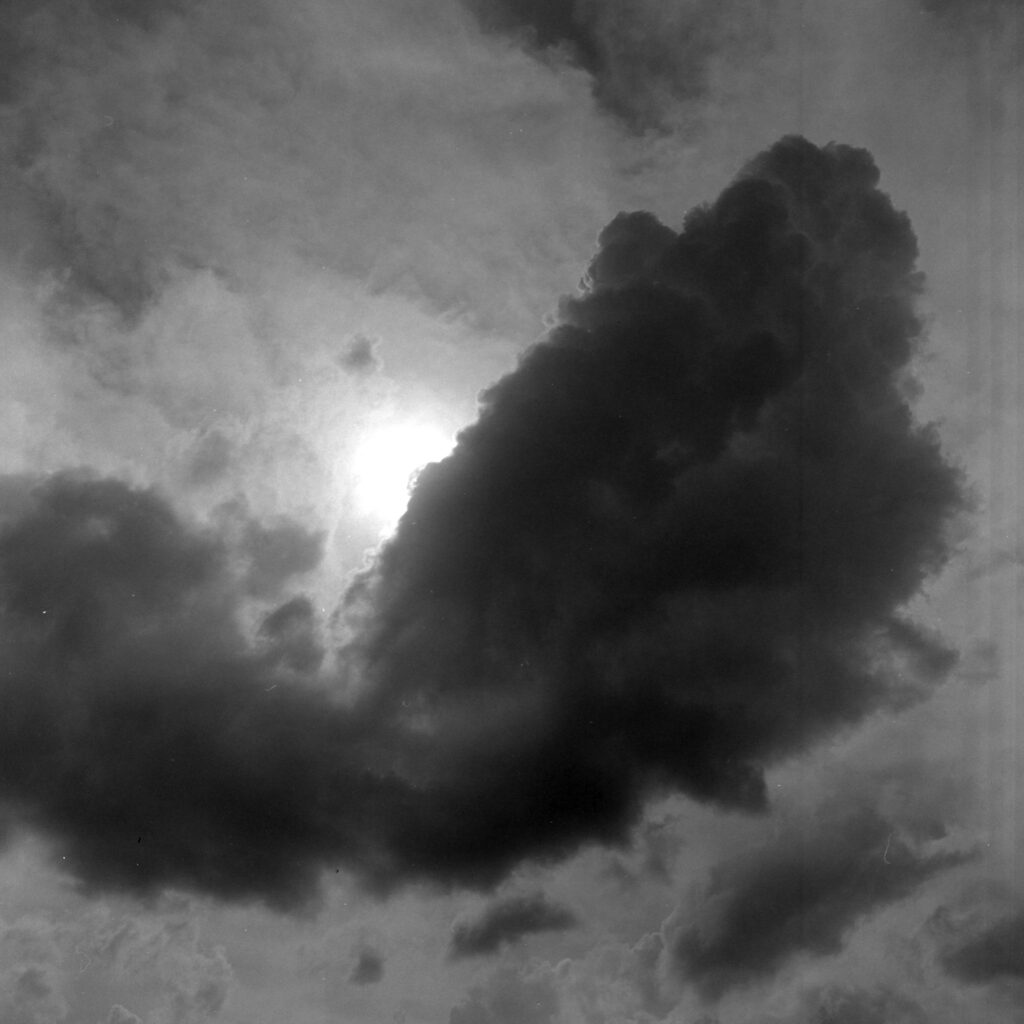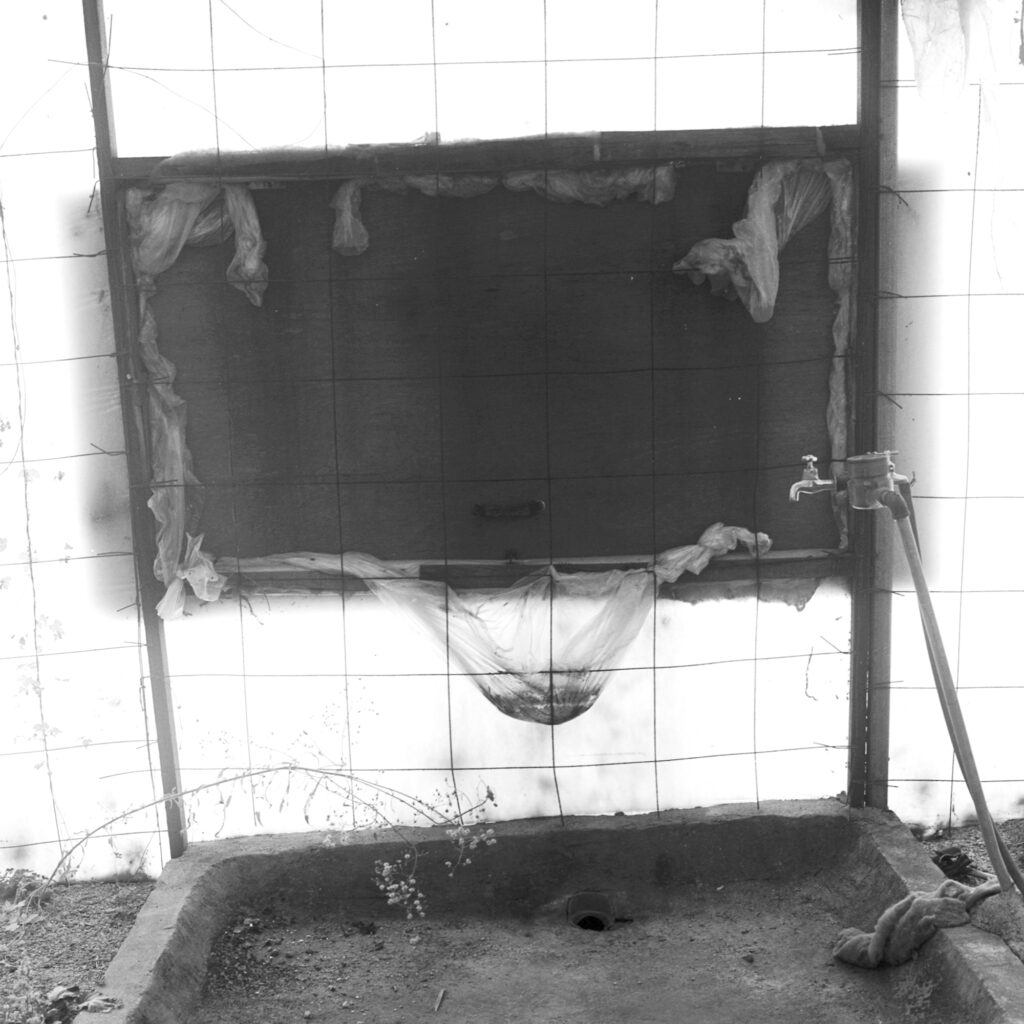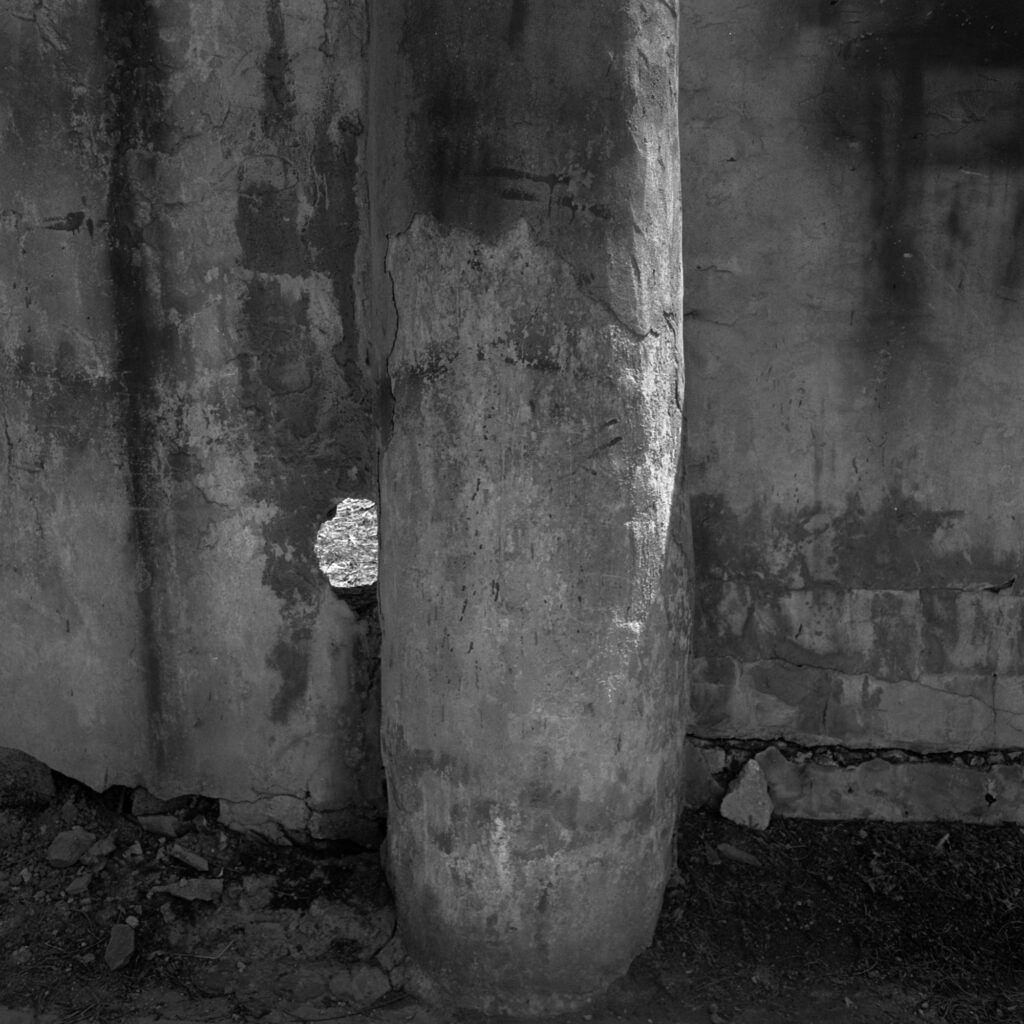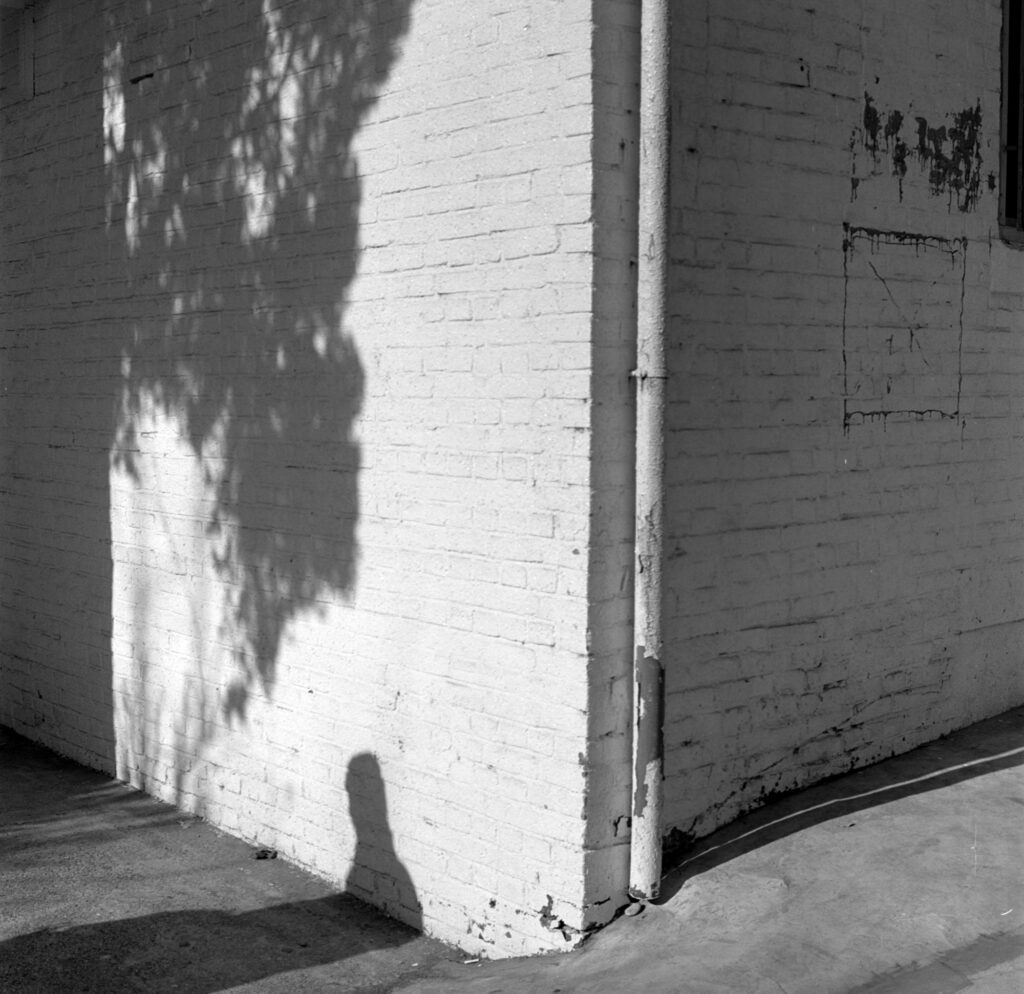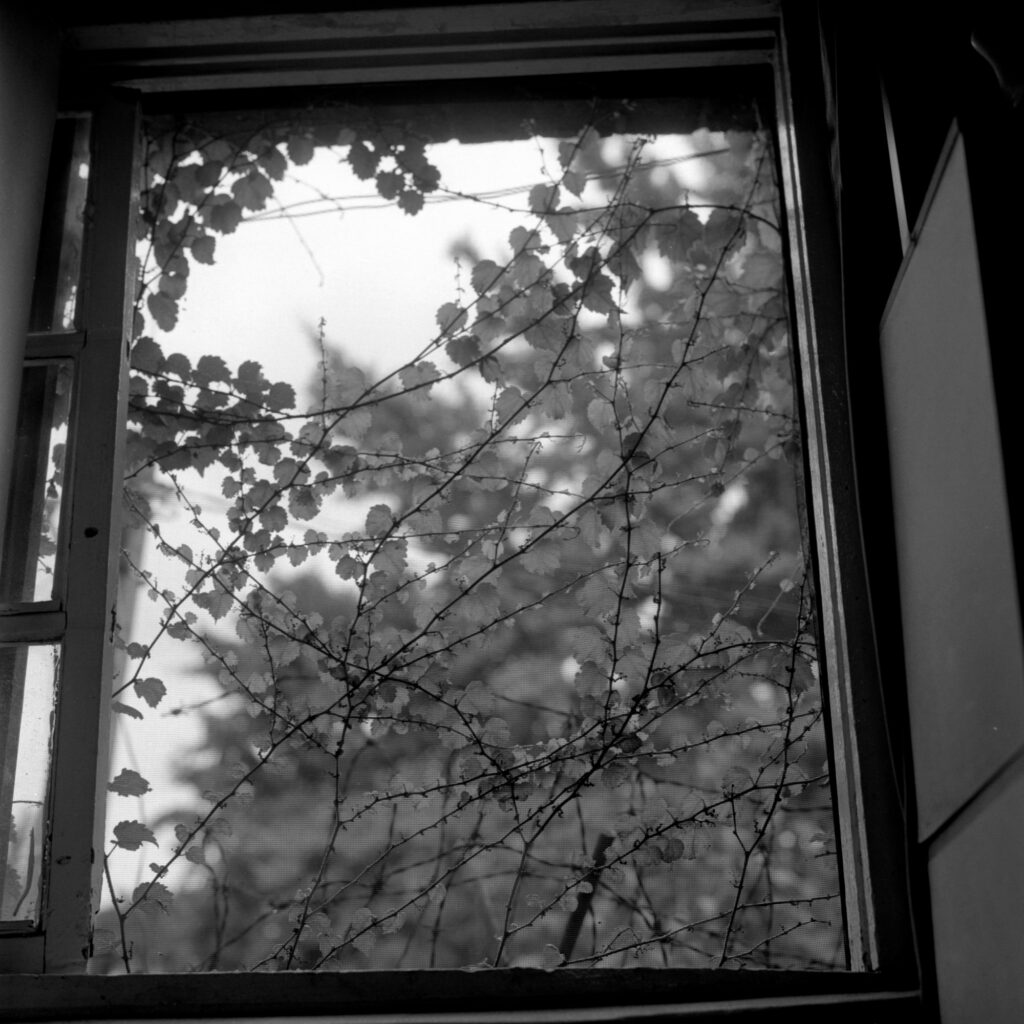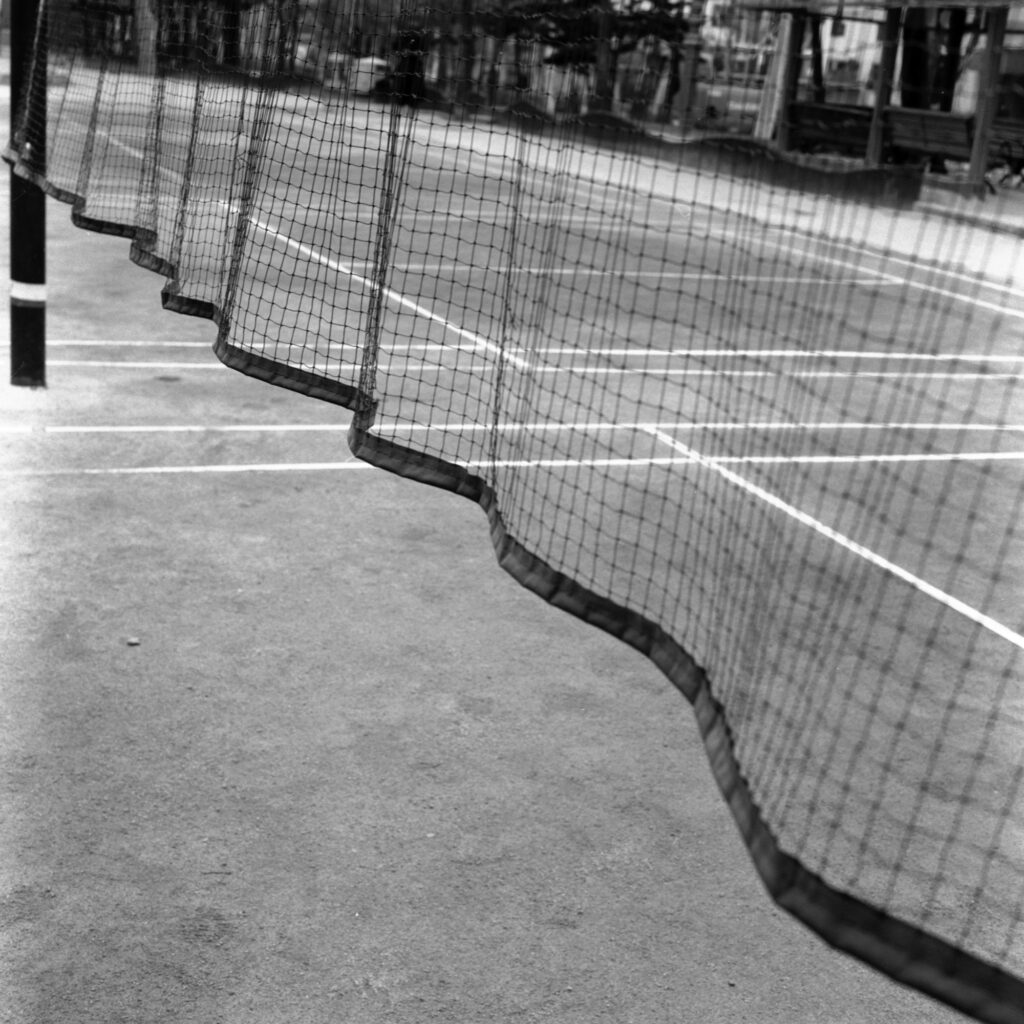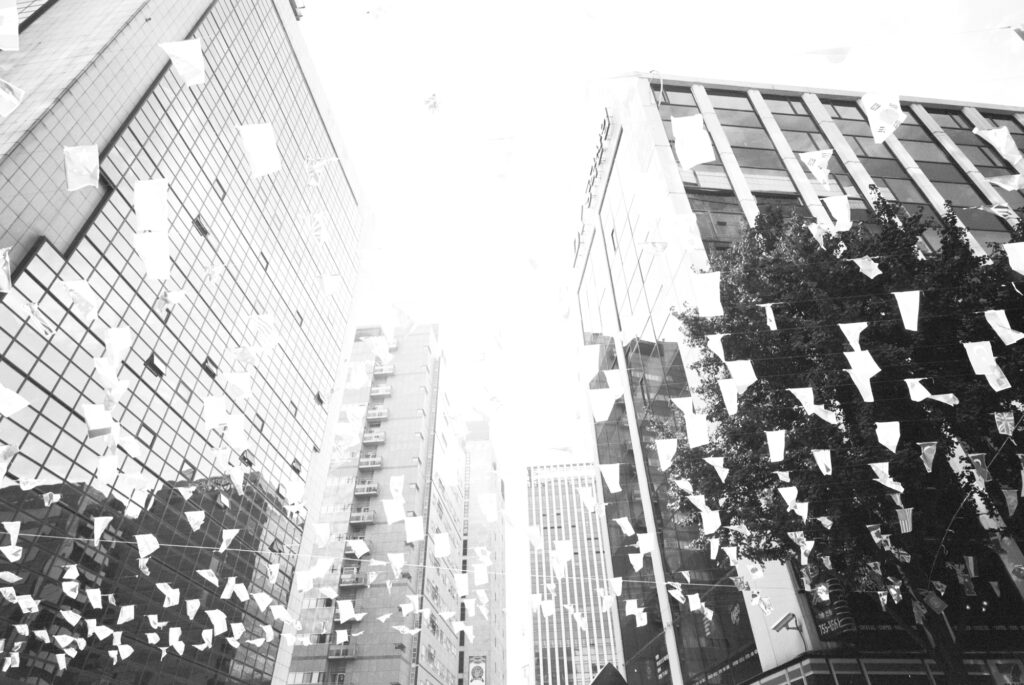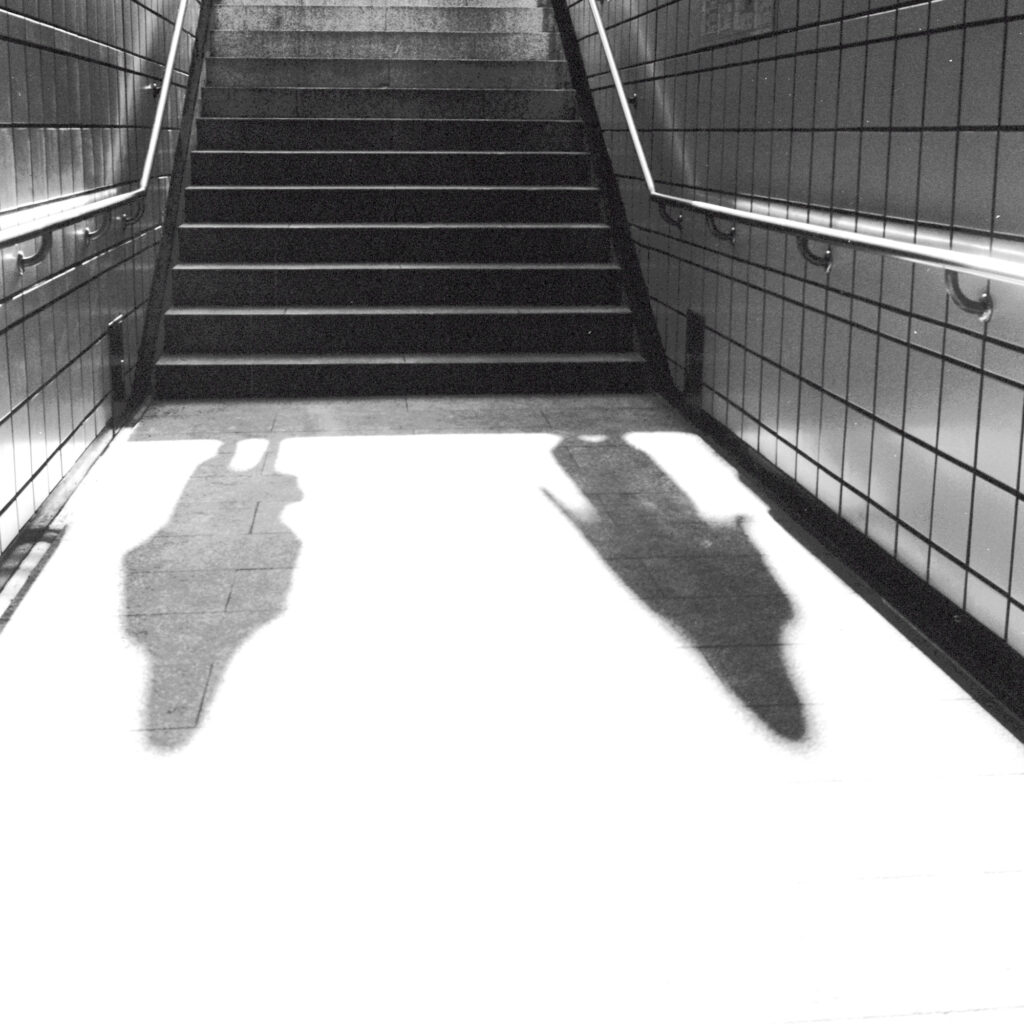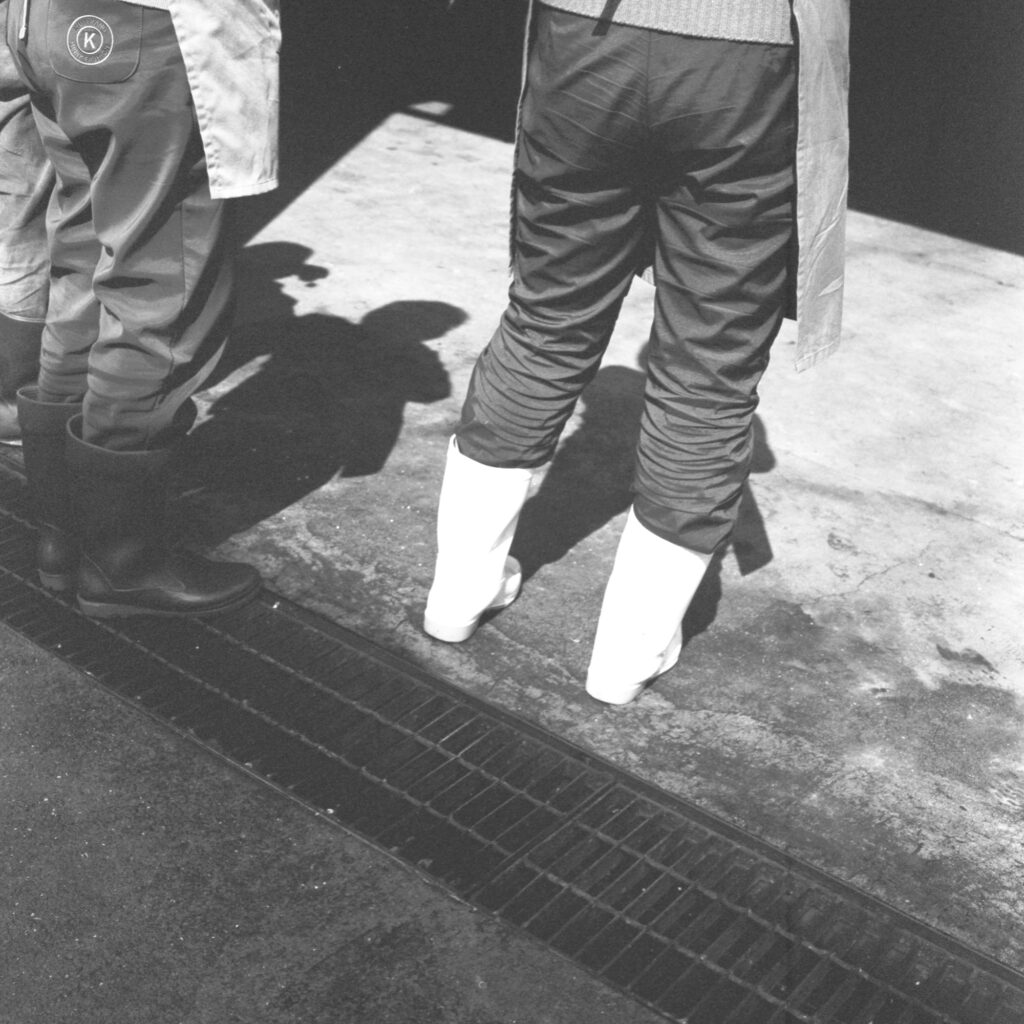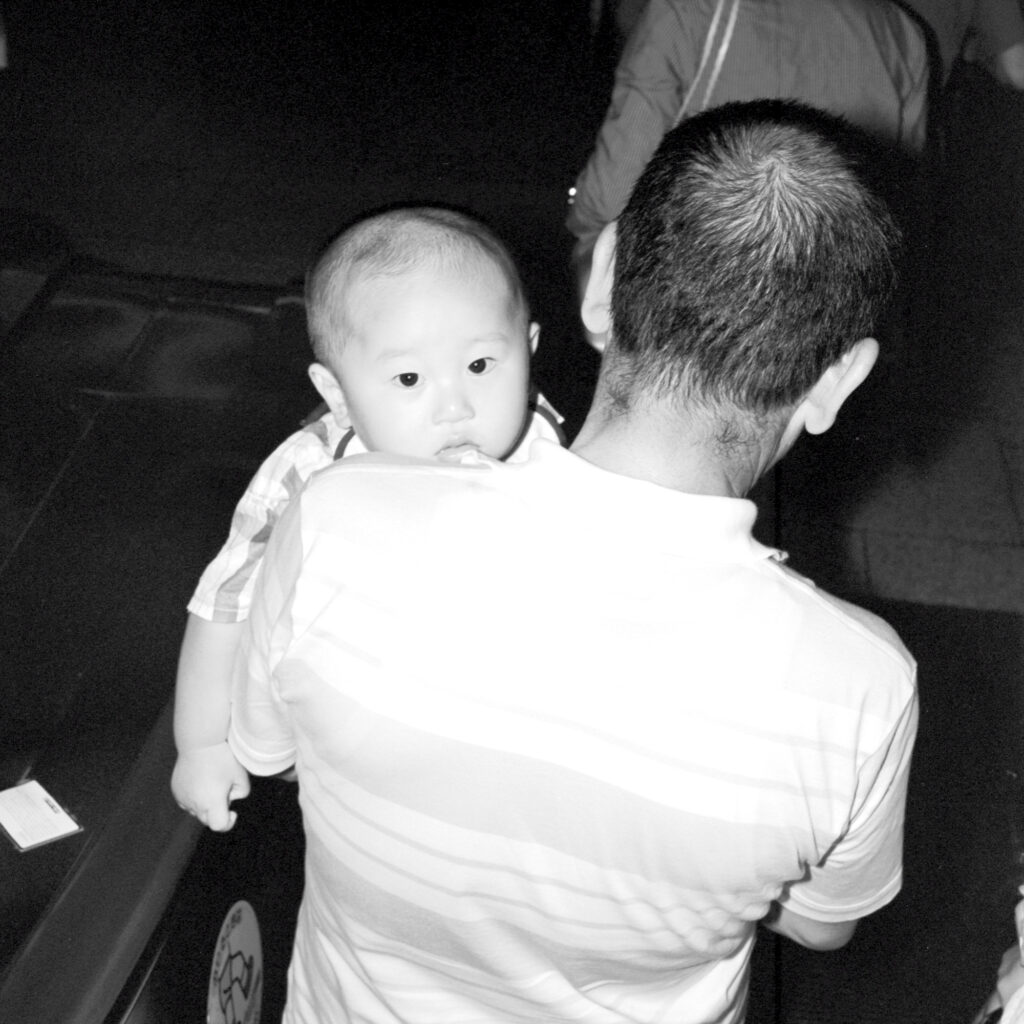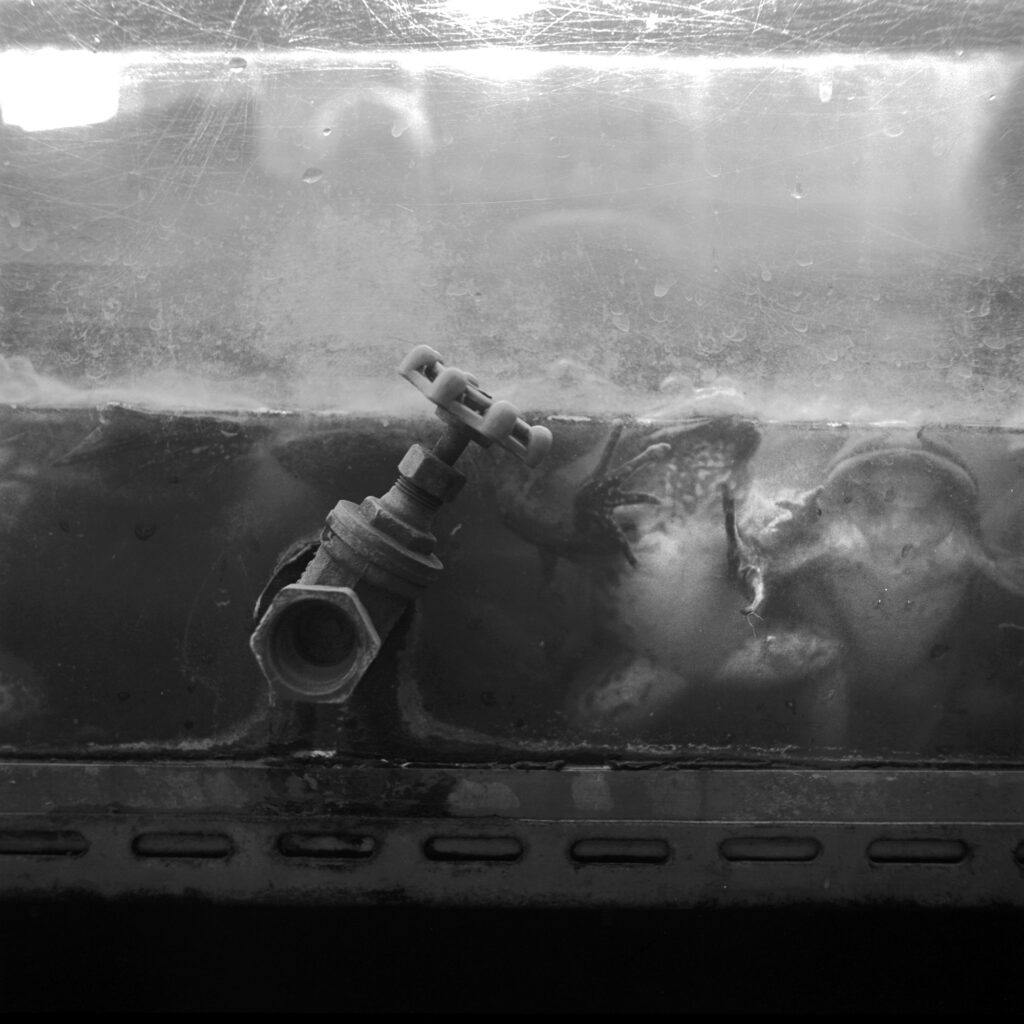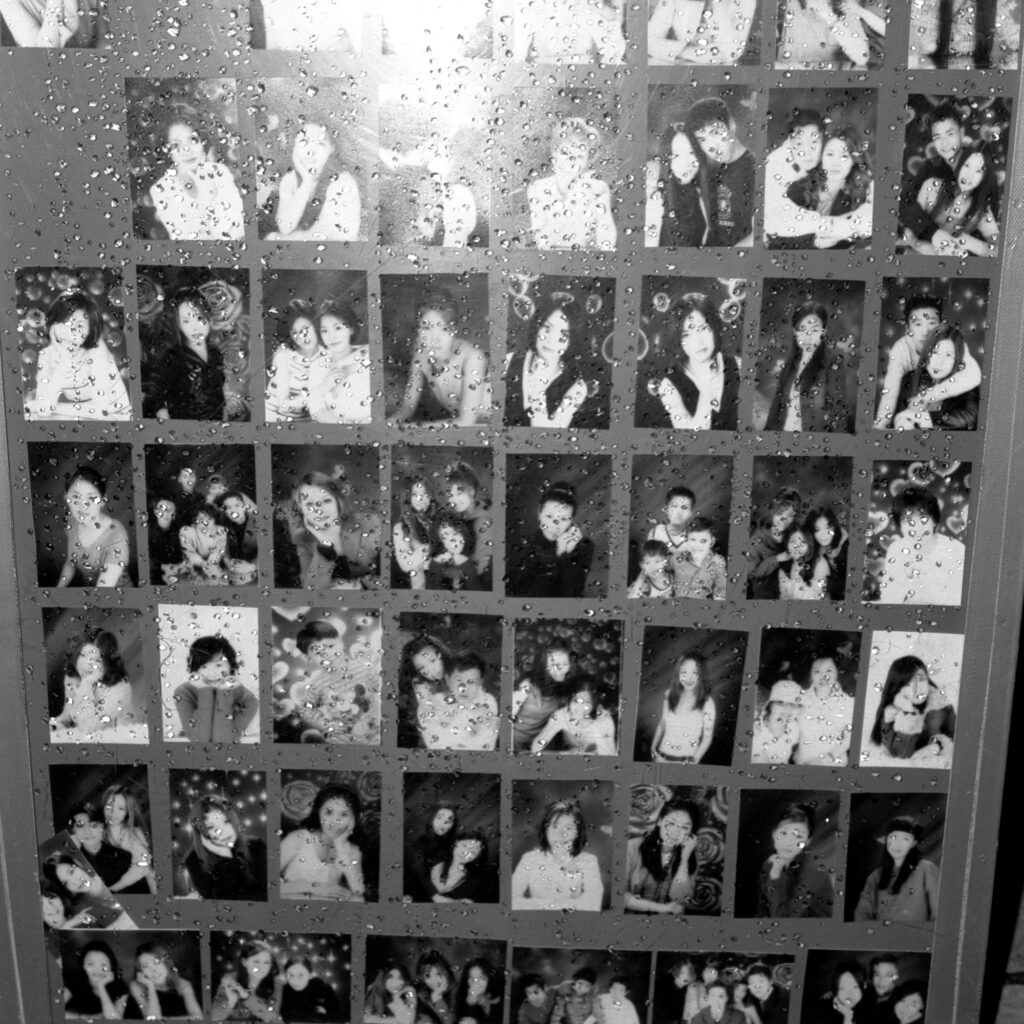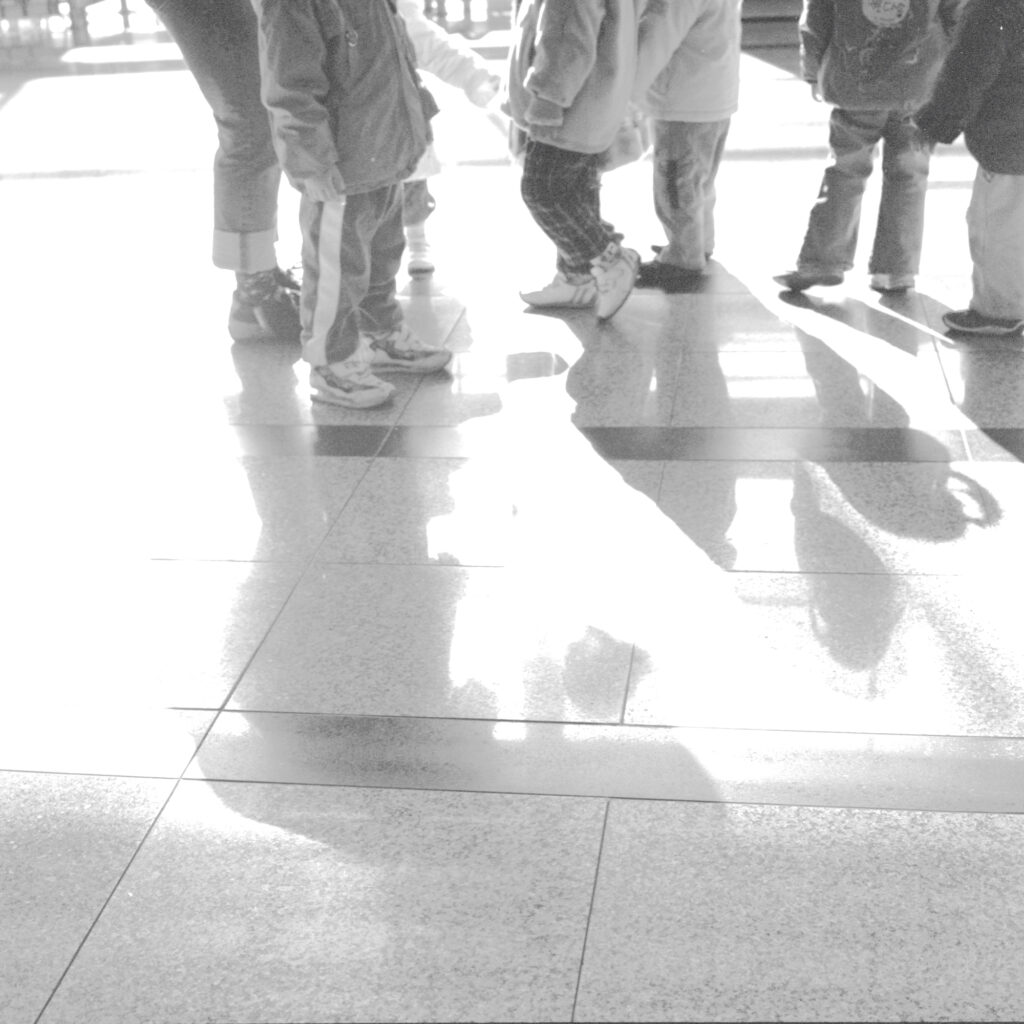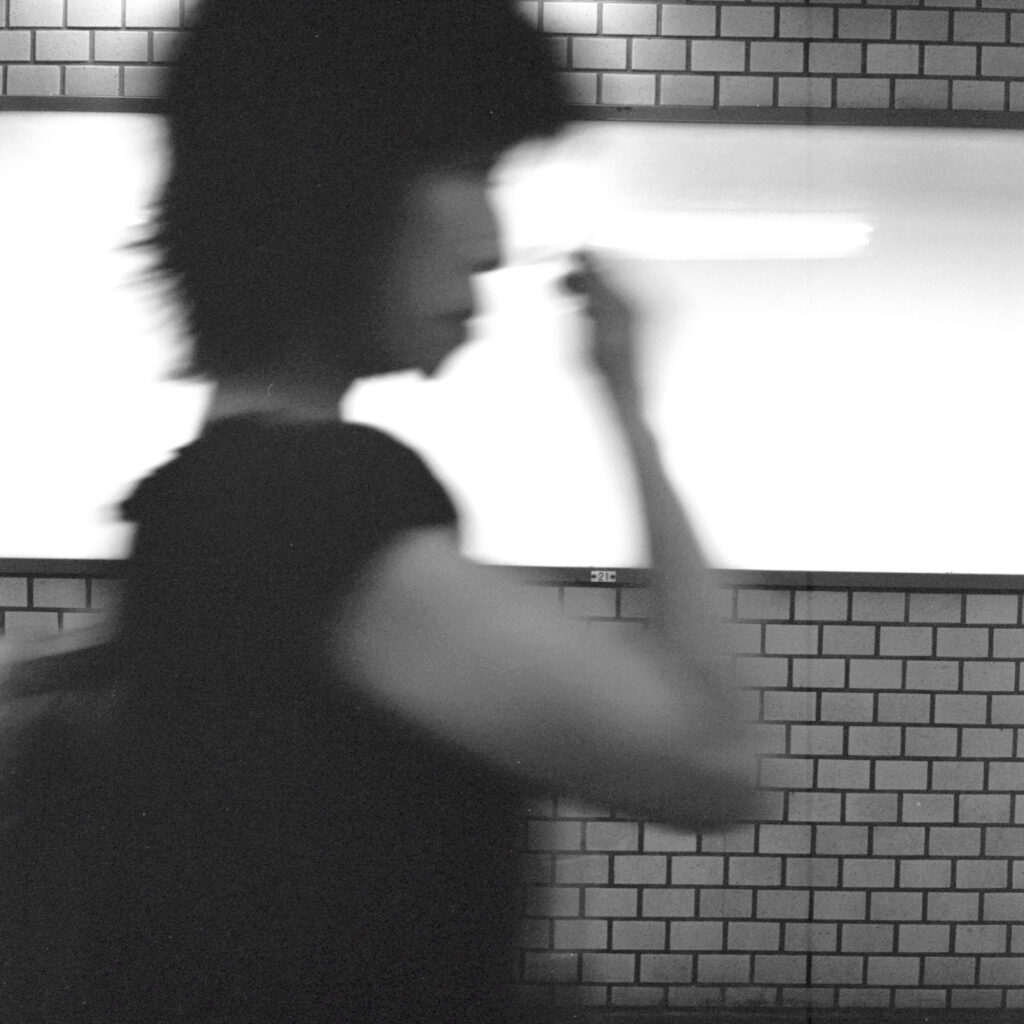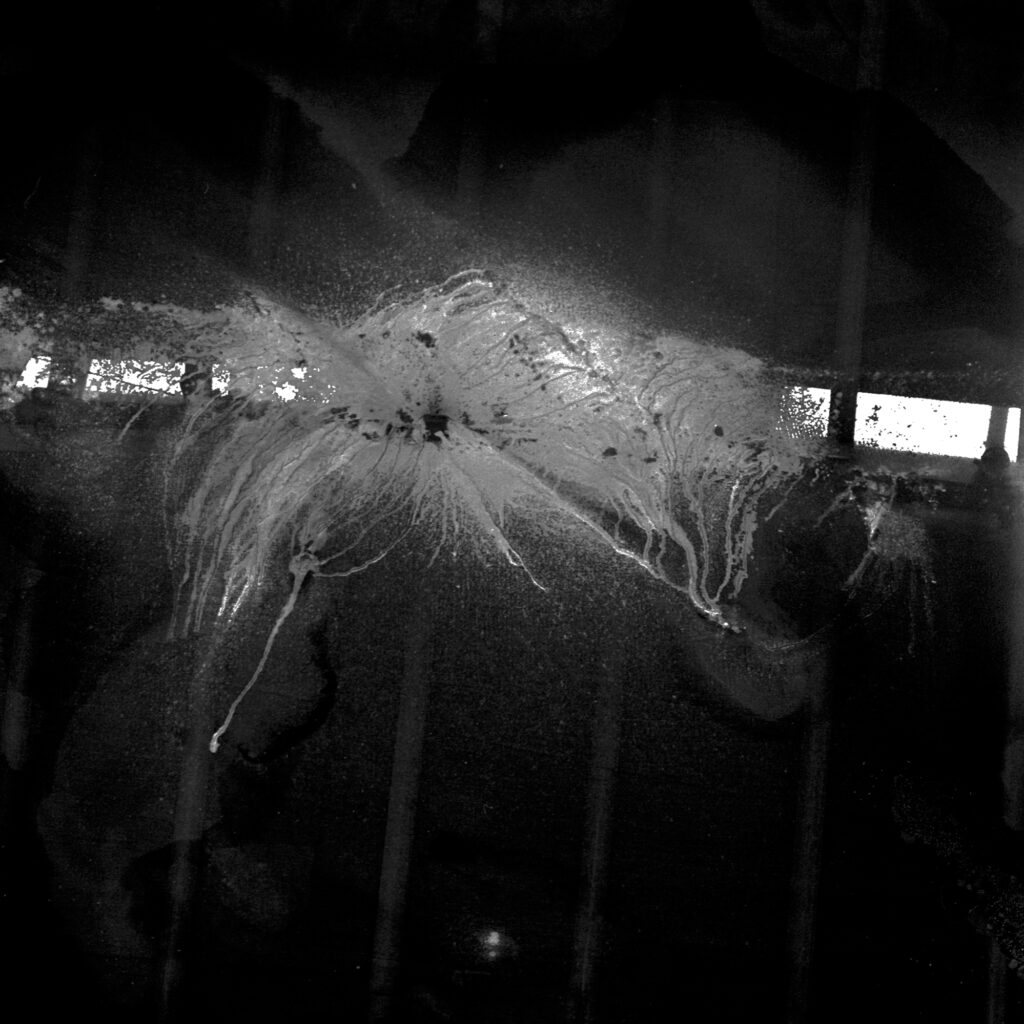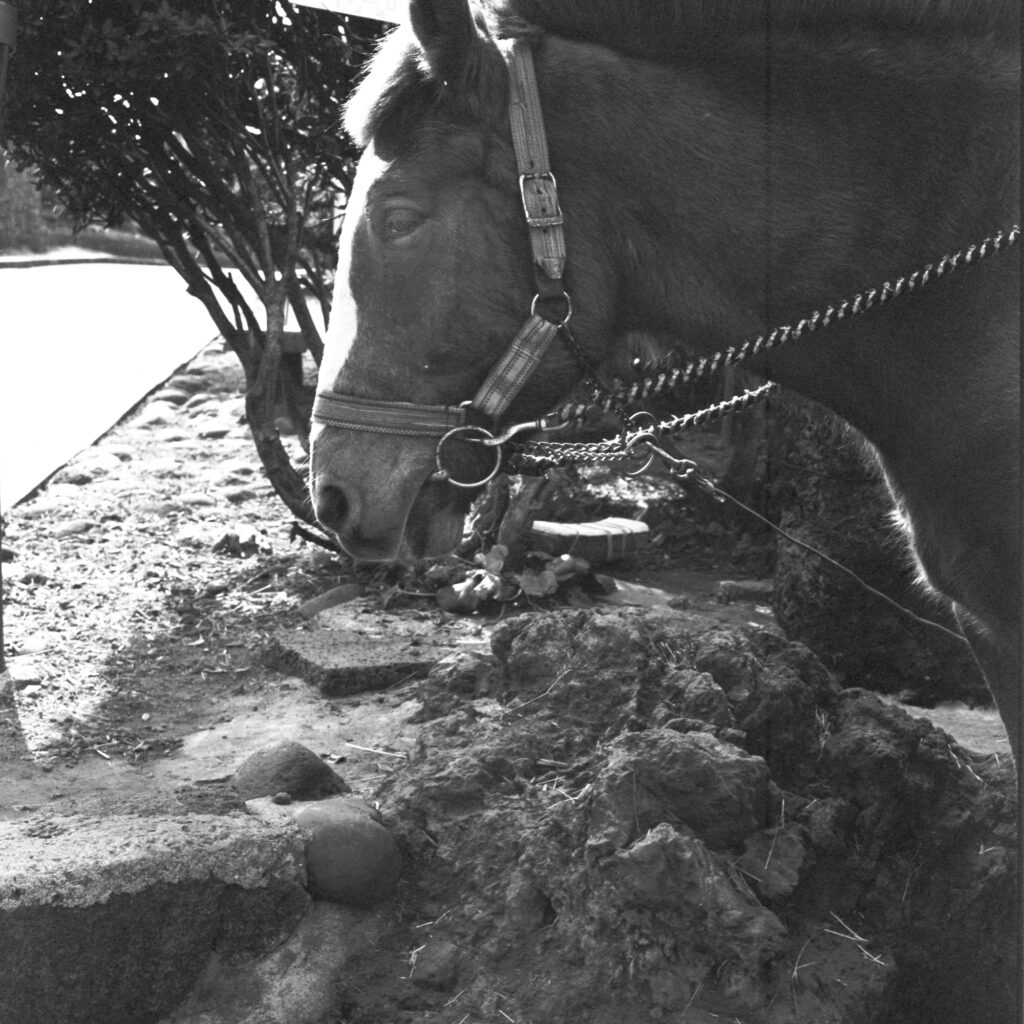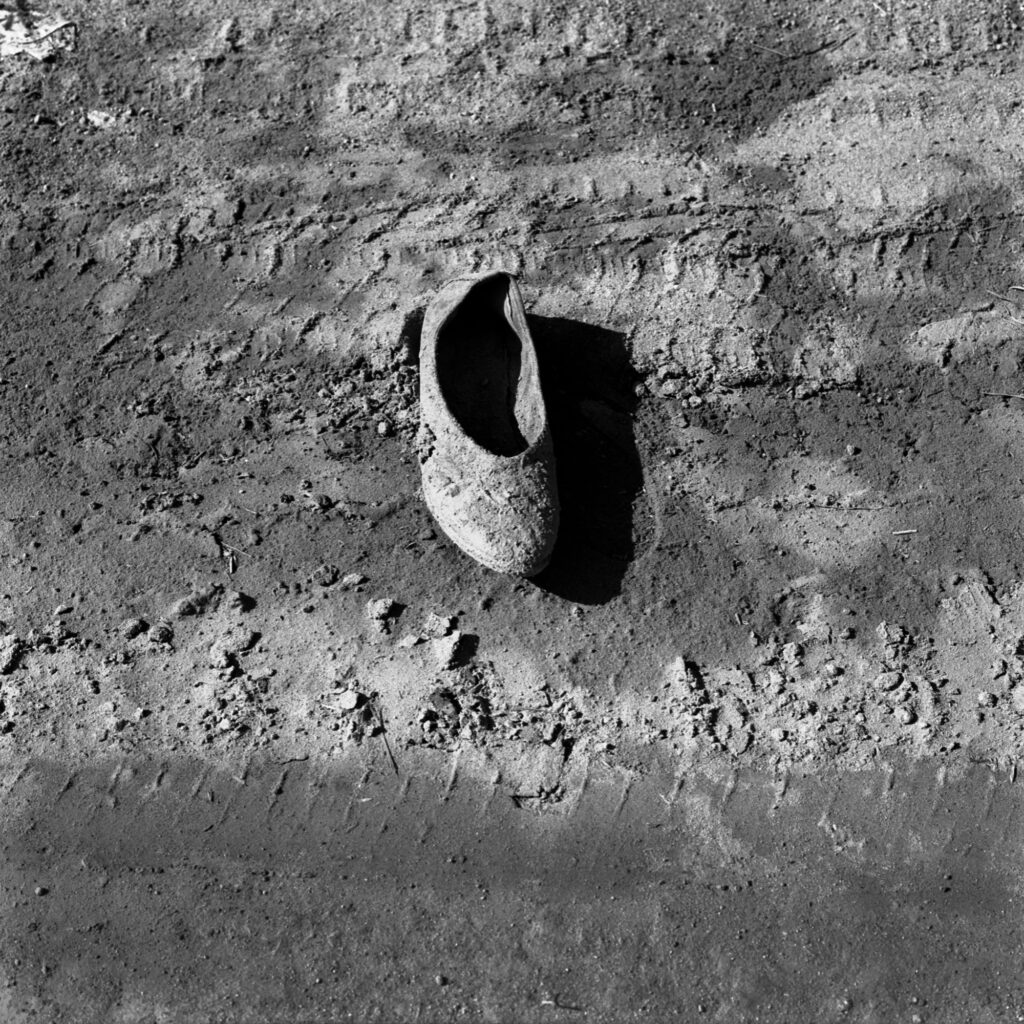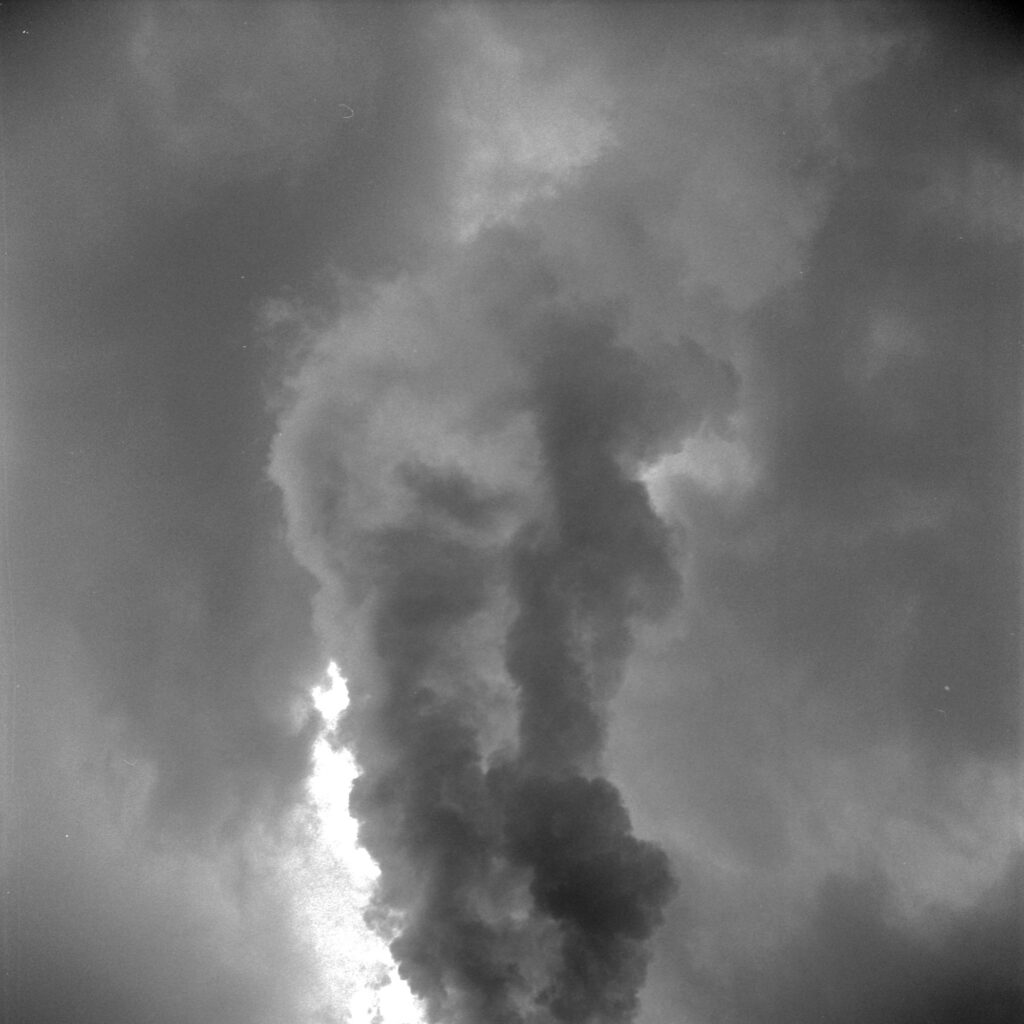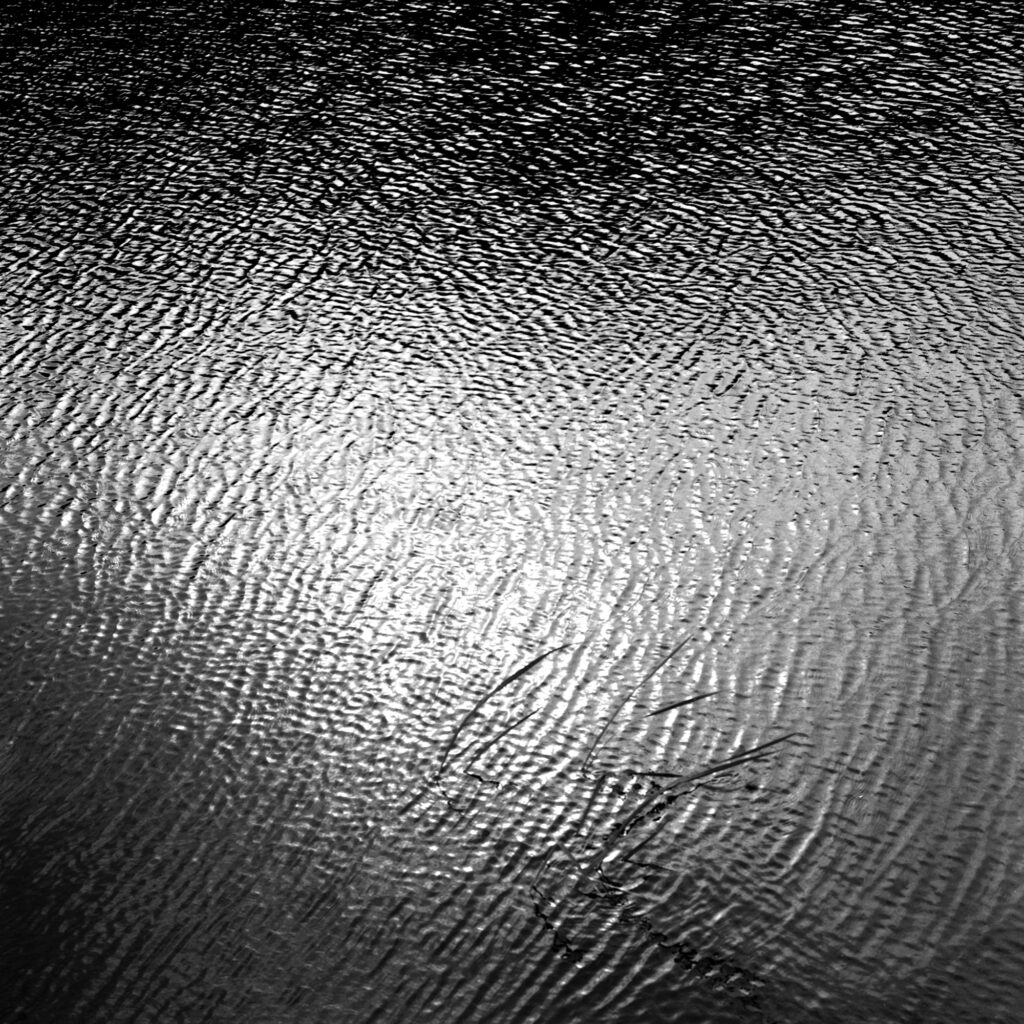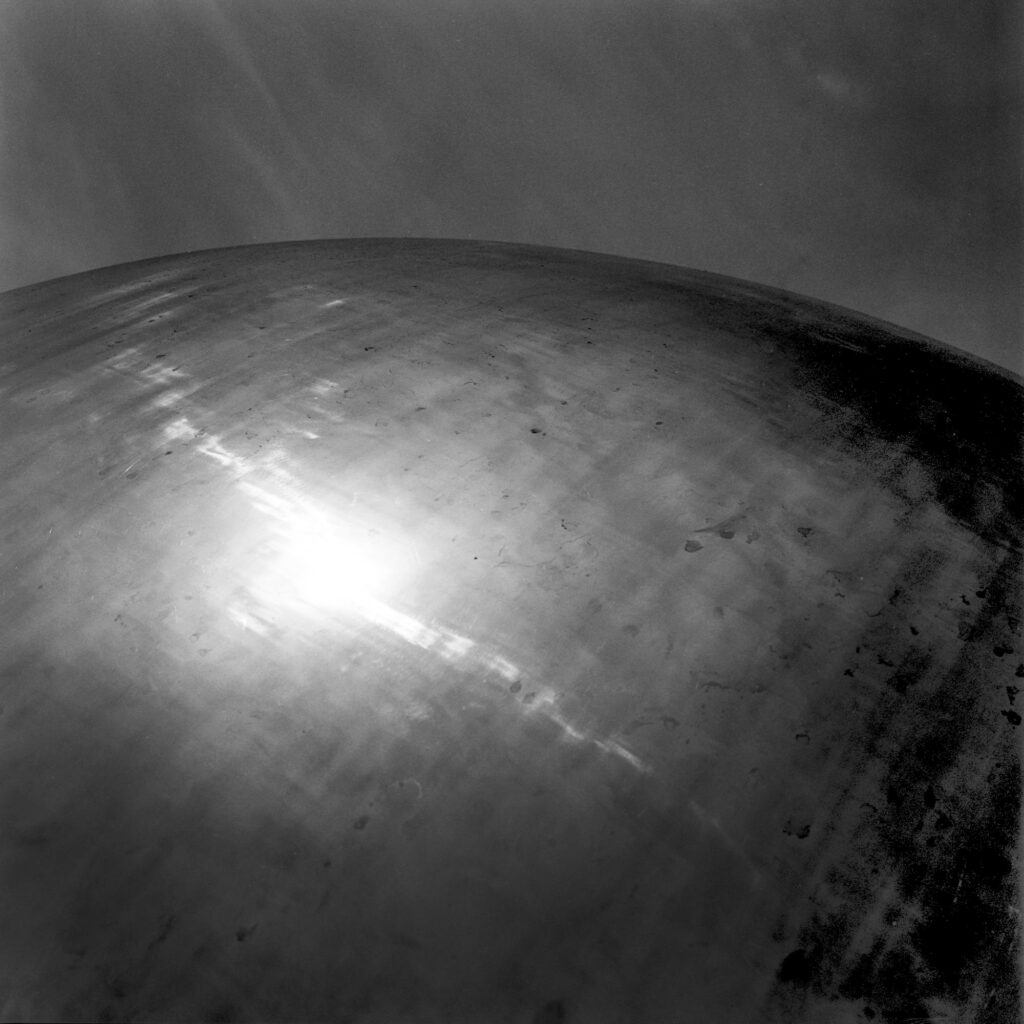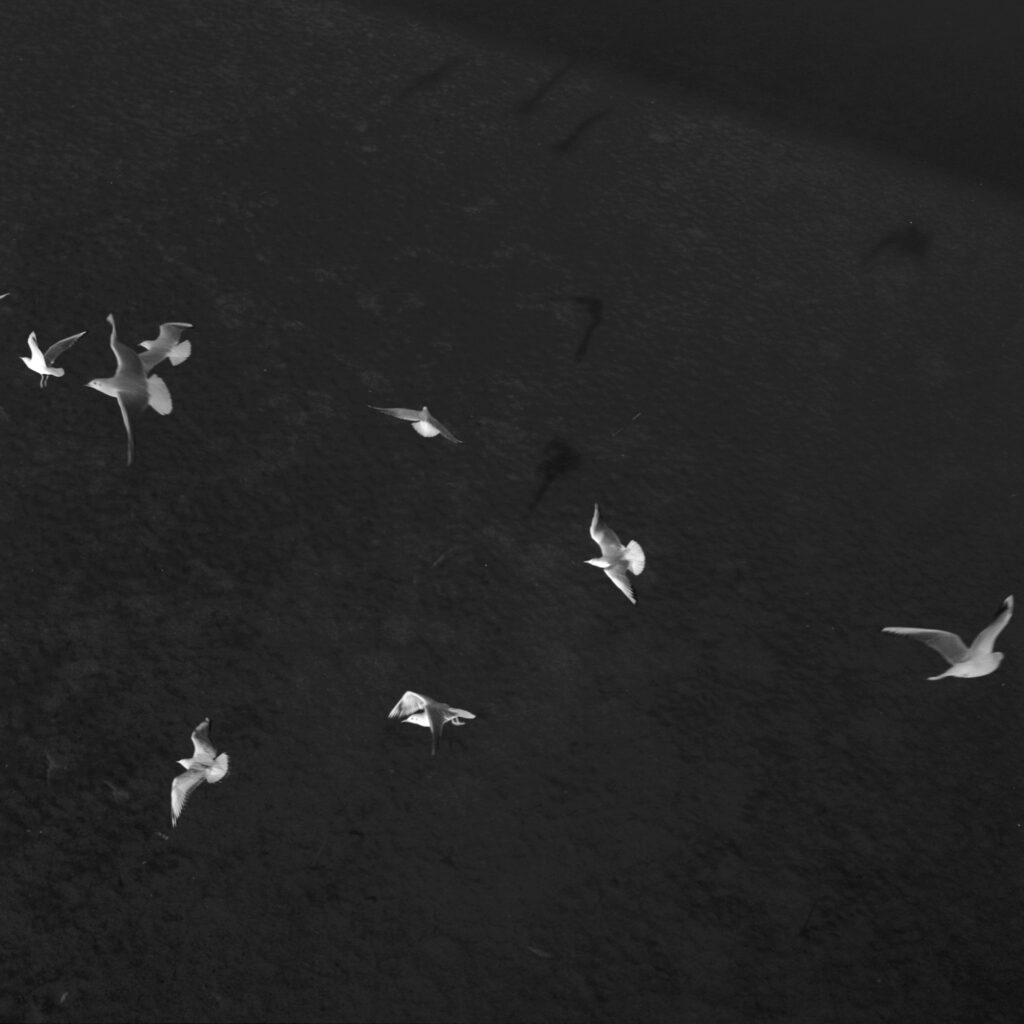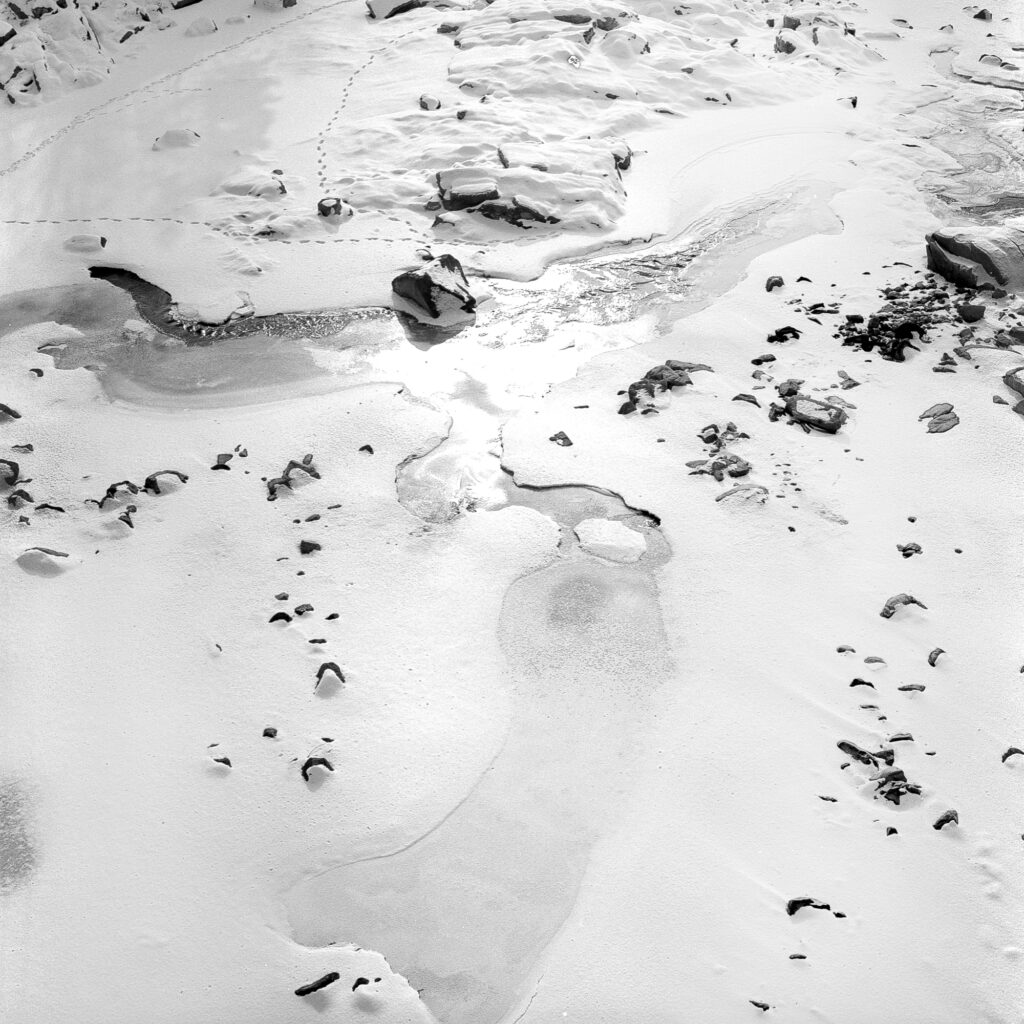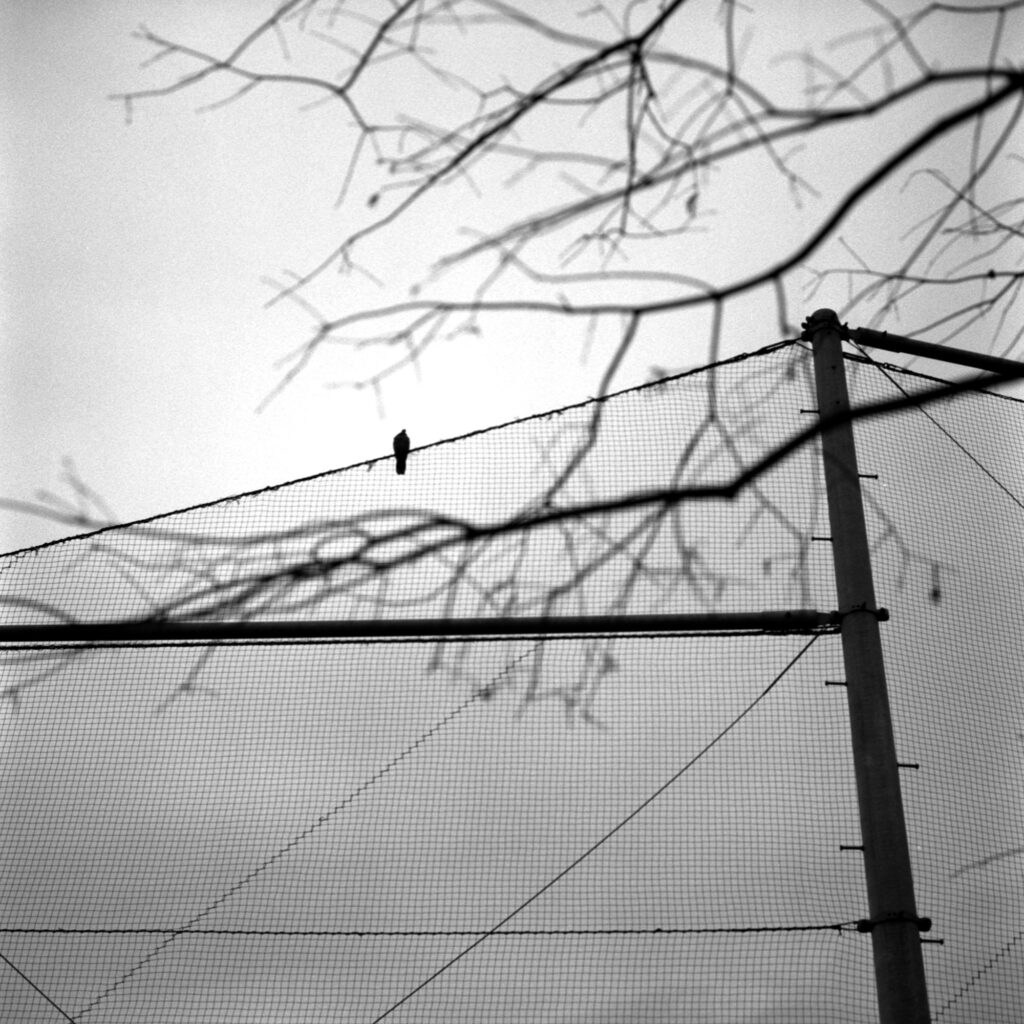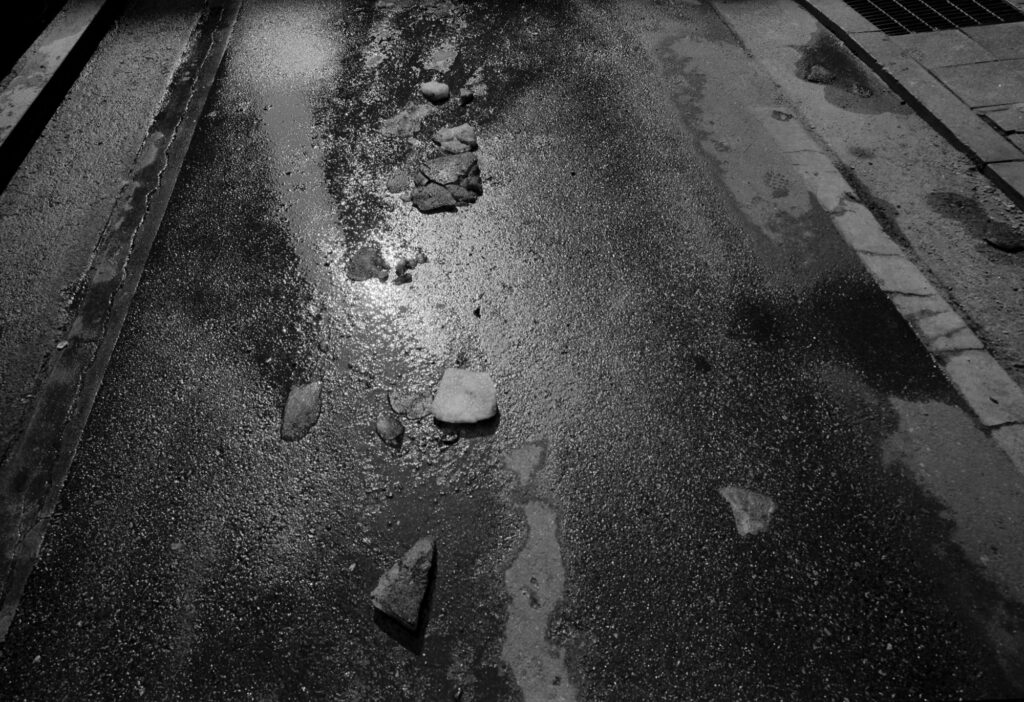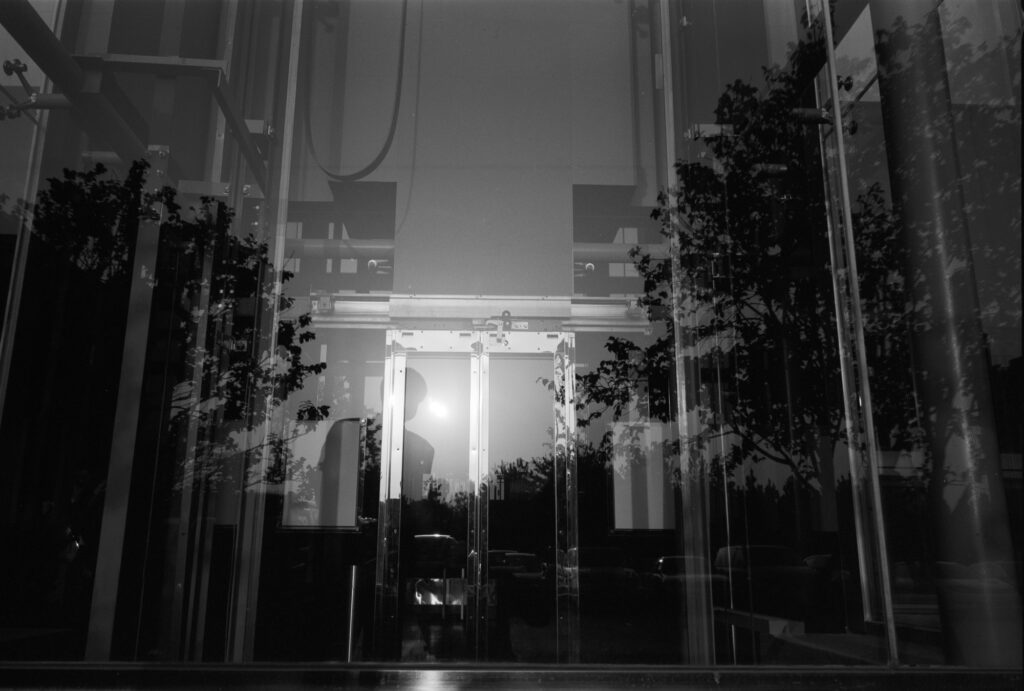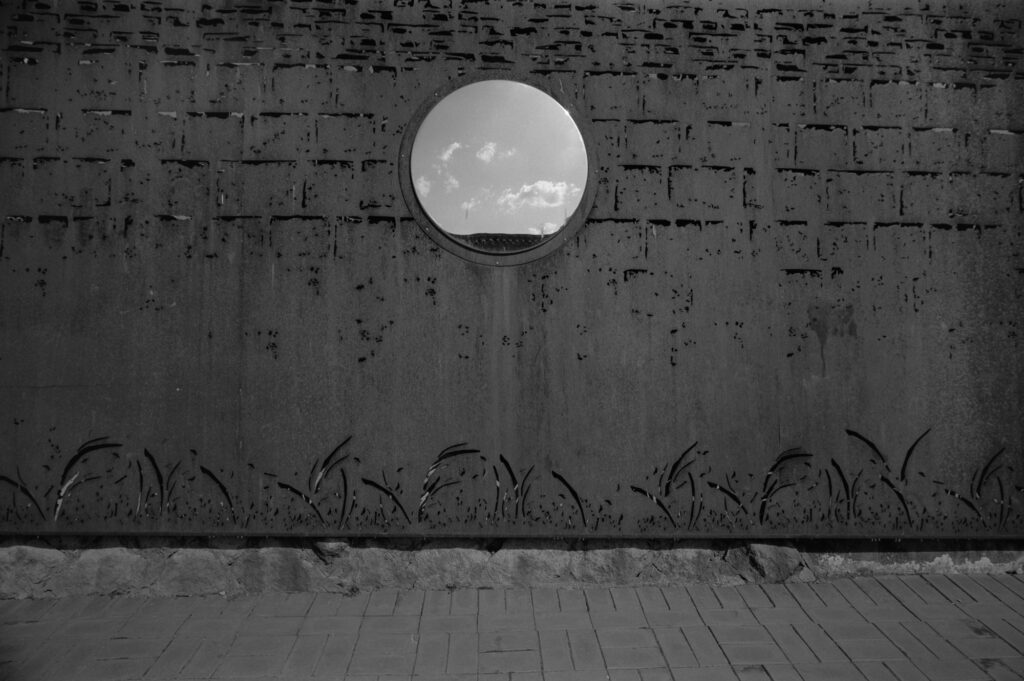비껴간 시선 끝에서 피어난 푸른 꽃
어둡다. 외롭다. 무섭다. 이번 전시에 선을 보인 이희상의 사진을 본 몇몇 사람들의 첫 반응이다. 버려진 것, 하찮은 것, 돌보아지지 않는 것, 이런 것들에 그는 주목한다. 애잔하고 스산하고 가련한 풍경들이다. 얼핏 보면 보잘 것 없어, 스윽 지나쳐가도 무방할 듯하다. 하지만, 그러나 잠시 발을 멈추어 그 속에 담긴 혹은 잠긴 작가의 비상한 시선에 동감해 보자. 그의 발과 눈은 거짓말을 모른다. 그가 사물을 어떻게 발견하는지, 생명의 리듬을 어떻게 탄생시키는지 주의깊게 살펴보자.
이희상의 작품에 비친 시선은 항상 비껴간다. 그는 정면을 직시하지 않는다. 정면 돌파를 피한다. 주변과 잉여와 가장자리와 경계로 그의 시선은 향한다. 하지만 그렇게 비껴간 마음의 끝자락에서 한 송이 푸른 꽃을 탐색한다. 주목하지 않던 보잘 것 없는 것들이 그의 비껴간 시선 속에서 새롭게 피어난다. 아무도 돌아보지 않는 생물과 사물 그리고 그들의 은밀한 소통에서 작가는 빛과 형태의 행복한 조우를 포착한다.
이게 과연 우연일까? 장화를 신은 인물 그리고 행인들의 하반신과 그림자 혹은 그림자만, 아빠의 어깨 너머로 드러난 아이의 무표정한 얼굴, 부식된 함석판의 깨져나간 형태와 그 그림자의 대화, 하복부가 오물로 찌든 얼룩소, 고삐와 어둠의 굴레 속에 갇힌 말의 슬픈 눈망울, 홀로 앉았거나 나는 새 혹은 새들, 하체를 나신으로 드러낸 여인 혹은 여인의 둔부 그리고 여인의 거슴츠레한 눈동자, 쇼우 윈도우에 갇힌 세련된 여자 마네킹, 생물로 진열된 갈치의 빛바랜 율동, 빗물로 얼룩져 보이는 사진관의 인물사진들, 탁한 수조에 갇힌 개구리와 삐딱한 수도관, 비닐하우스 혹은 시멘트벽에 무심히 걸려 있는 직사각 형태의 구조물 그리고 거기에 무심히 걸려 있는 비닐이 뿜어내는 주름진 명암의 계조, 헐어서 껍질이 벗겨져 나간 돌기둥의 뭉툭한 의지, 땀 흘리는 둥근 물체 그리고 그 위에 섬광처럼 흩어지는 불빛의 형상, 공허한 뒷골목, 빌딩숲 사이로 뜻 없이 흩날리는 만국기, 상가 건물 위에서 스스로 놀아나는 놀이기구, 무념으로 피어나거나 노니는 구름들. 아 그러나 그 끝에서 찬연히 빛나는 잔물결들, 지면으로 떨어져 다시 피어오르는 물줄기들, 아무렇게나 걸려 있는 하얀 빨래 사이에서 피어나는 아이들 낙서의 꿈, 사각의 구멍과 그 사이의 휘어진 쇠의 형태가 빚어내는 인물상, 그리고 무엇보다 마른 진흙땅에 오롯이 홀로의 의지를 드러내는 흙투성이 신발.
뒤, 아래, 홀로, 공허, 그림자, 하반신, 찌든, 탁한, 얼룩진, 주름진, 삐딱한. 이런 어휘들에서 이희상의 작품세계 밑바닥에 흐르는 정조와 그의 시선을 감지할 수 있다. 그의 시선은 중심 선(線) 밖으로 나아간다. 그어놓은 경계선을 넘어선다. 하지만 월경(越境)은 위험하다. 거기는 정돈된 온실이 아니라 무질서한 야생이다. 틀과 격이 없어 거칠고 험하다. 선 밖은 자유로우나 안전하지 않다. 항상 긴장을 요구한다. 선 밖으로 나아간 자는 불안과 고독과 고통을 감수해야 한다. 그 길을 이희상은 묵묵히 기꺼이 따라간다. 그리하여 자유로운 사진이 아니라 ‘사진적인 자유’를 추구한다. 그가 선 밖에서 획득한 자유에는 선 안에서 누릴 수 없는 풍요가 있다. 그래서 아이러니컬하게도 불편하게 편안하다. 차갑게 따뜻하다. 외롭게 함께 있다. 선 밖으로 나간 자에게만 주어지는 예기치 않은 미학적 그리고 윤리적 선물이다.
이희상의 비껴간 시선에 포착된 사진 이미지에서 노발리스의 ‘푸른 꽃’을 상상하는 건 무리일까? 그는 미완의 소설 <푸른 꽃>에서 이렇게 읊조린다. “보물 때문에 내 마음 속에 이렇게 말할 수 없는 그리움이 들끓는 것은 아냐. 나는 탐욕하고는 거리가 먼 사람이지. 그렇지만 그 푸른 꽃은 꼭 한번 보고 싶어. 그 꽃은 잠시도 내 마음속에서 떠나질 않아. 나는 푸른 꽃에 대해서만 생각하고 그것을 시로 쓰고 싶어. ... 그 푸른 꽃이 뚜렷하게 보이지 않으면 나는 걷잡을 수 없는 깊은 혼란에 사로잡히곤 해.” 이희상도 선 밖으로 나가 ‘푸른 꽃’을 찾아 나선다. 그 점에서 그도 낭만주의자다. 또한 이상주의자이며 신비주의자다. 밝은 현실에서 시선을 돌려 중심에서 벗어난 칙칙하고 어두운 것들 속에 살아있는 숨결을 감지하고 포착한다. 중심의 빛나는 힘을 거부하고 그는 주변의 미약한 생기에 주목한다. 선 밖으로 나간 아이의 마음이 이와 다를까?
이희상의 작품 가운데 ‘흙길에 놓인 채 마른 흙으로 범벅된 신발’에 나는 특히 주목한다. 이 사진은 고흐의 <농부의 신발>을 연상시킨다. ‘고흐의 신발’에 대해 하이데거는 다음과 같이 서술한다. “신발이라는 도구의 밖으로 드러난 내부의 어두운 열림에서 일하는 이의 발걸음에 담긴 노고를 응시한다. 신발이라는 도구의 실팍한 무게에서 거친 바람이 부는 넓게 펼쳐진 평탄한 밭고랑을 유유히 걷는 걸음걸이의 강인함이 쌓여 있다. ... 신발창 아래에는 저물녘 들길의 고독이 배어 있다.” 물론 이희상의 신발은 고흐의 신발과 다르다. 거기에서는 하이데거가 말하는 대지의 혜택이나 풍요의 선물을 기대할 수 없다. 오히려 그 반대다. 이희상의 신발은 대지에서 밀려나고 대지에게 거부당한, 그래서 아무런 긍정이나 기대를 품을 수 없는 도구이다. 더 이상 도구로서의 가치를 지니지 않은, 주인에게서도 버려진, 고독한 신발이다. 그래도, 그럼에도 신발은 신발로서의 자기를 주장하고 있다. 이 신발의 존재의미는 무엇일까?
그의 작품은 보면 볼수록 새롭게 보인다. 자꾸 봐도 질리지 않는다. 물이나 밥처럼 적극적으로 유혹하는 손길이 없기 때문이다. 작품 속의 이미지들은 보아 달라 아우성치지 않는다. 소극적으로 기다린다. 은은하고 은근하여, 아무 맛이 없어 보이는데도 깊은 맛을 느끼면 벗어나기 힘들다. 최고의 음식에는 ‘맛’이 없는 법이다.
프랑스 영화 <샤콘느>의 마지막 장면이다. 오케스트라에서 밀려난 바이올리니스트가 파리의 컴컴한 배수로에 들어가 홀로 바흐의 바이올린 독주곡 샤콘느를 연주하자 배수로의 짙은 어둠을 뚫고 서서히 인기척이 일면서 그곳에서 잠을 청하던 노숙자들이 하나 둘 밝게 고개를 들기 시작한다. 이희상의 이번 전시 <은밀한 소환>은 바흐 샤콘느의 리듬을 타고, 어둠과 주변의 휴머니즘을 살려내 푸른 꽃의 희망과 의지를 제시한다.
유헌식(문예비평가 단국대 교수)
어둡다. 외롭다. 무섭다. 이번 전시에 선을 보인 이희상의 사진을 본 몇몇 사람들의 첫 반응이다. 버려진 것, 하찮은 것, 돌보아지지 않는 것, 이런 것들에 그는 주목한다. 애잔하고 스산하고 가련한 풍경들이다. 얼핏 보면 보잘 것 없어, 스윽 지나쳐가도 무방할 듯하다. 하지만, 그러나 잠시 발을 멈추어 그 속에 담긴 혹은 잠긴 작가의 비상한 시선에 동감해 보자. 그의 발과 눈은 거짓말을 모른다. 그가 사물을 어떻게 발견하는지, 생명의 리듬을 어떻게 탄생시키는지 주의깊게 살펴보자.
이희상의 작품에 비친 시선은 항상 비껴간다. 그는 정면을 직시하지 않는다. 정면 돌파를 피한다. 주변과 잉여와 가장자리와 경계로 그의 시선은 향한다. 하지만 그렇게 비껴간 마음의 끝자락에서 한 송이 푸른 꽃을 탐색한다. 주목하지 않던 보잘 것 없는 것들이 그의 비껴간 시선 속에서 새롭게 피어난다. 아무도 돌아보지 않는 생물과 사물 그리고 그들의 은밀한 소통에서 작가는 빛과 형태의 행복한 조우를 포착한다.
이게 과연 우연일까? 장화를 신은 인물 그리고 행인들의 하반신과 그림자 혹은 그림자만, 아빠의 어깨 너머로 드러난 아이의 무표정한 얼굴, 부식된 함석판의 깨져나간 형태와 그 그림자의 대화, 하복부가 오물로 찌든 얼룩소, 고삐와 어둠의 굴레 속에 갇힌 말의 슬픈 눈망울, 홀로 앉았거나 나는 새 혹은 새들, 하체를 나신으로 드러낸 여인 혹은 여인의 둔부 그리고 여인의 거슴츠레한 눈동자, 쇼우 윈도우에 갇힌 세련된 여자 마네킹, 생물로 진열된 갈치의 빛바랜 율동, 빗물로 얼룩져 보이는 사진관의 인물사진들, 탁한 수조에 갇힌 개구리와 삐딱한 수도관, 비닐하우스 혹은 시멘트벽에 무심히 걸려 있는 직사각 형태의 구조물 그리고 거기에 무심히 걸려 있는 비닐이 뿜어내는 주름진 명암의 계조, 헐어서 껍질이 벗겨져 나간 돌기둥의 뭉툭한 의지, 땀 흘리는 둥근 물체 그리고 그 위에 섬광처럼 흩어지는 불빛의 형상, 공허한 뒷골목, 빌딩숲 사이로 뜻 없이 흩날리는 만국기, 상가 건물 위에서 스스로 놀아나는 놀이기구, 무념으로 피어나거나 노니는 구름들. 아 그러나 그 끝에서 찬연히 빛나는 잔물결들, 지면으로 떨어져 다시 피어오르는 물줄기들, 아무렇게나 걸려 있는 하얀 빨래 사이에서 피어나는 아이들 낙서의 꿈, 사각의 구멍과 그 사이의 휘어진 쇠의 형태가 빚어내는 인물상, 그리고 무엇보다 마른 진흙땅에 오롯이 홀로의 의지를 드러내는 흙투성이 신발.
뒤, 아래, 홀로, 공허, 그림자, 하반신, 찌든, 탁한, 얼룩진, 주름진, 삐딱한. 이런 어휘들에서 이희상의 작품세계 밑바닥에 흐르는 정조와 그의 시선을 감지할 수 있다. 그의 시선은 중심 선(線) 밖으로 나아간다. 그어놓은 경계선을 넘어선다. 하지만 월경(越境)은 위험하다. 거기는 정돈된 온실이 아니라 무질서한 야생이다. 틀과 격이 없어 거칠고 험하다. 선 밖은 자유로우나 안전하지 않다. 항상 긴장을 요구한다. 선 밖으로 나아간 자는 불안과 고독과 고통을 감수해야 한다. 그 길을 이희상은 묵묵히 기꺼이 따라간다. 그리하여 자유로운 사진이 아니라 ‘사진적인 자유’를 추구한다. 그가 선 밖에서 획득한 자유에는 선 안에서 누릴 수 없는 풍요가 있다. 그래서 아이러니컬하게도 불편하게 편안하다. 차갑게 따뜻하다. 외롭게 함께 있다. 선 밖으로 나간 자에게만 주어지는 예기치 않은 미학적 그리고 윤리적 선물이다.
이희상의 비껴간 시선에 포착된 사진 이미지에서 노발리스의 ‘푸른 꽃’을 상상하는 건 무리일까? 그는 미완의 소설 <푸른 꽃>에서 이렇게 읊조린다. “보물 때문에 내 마음 속에 이렇게 말할 수 없는 그리움이 들끓는 것은 아냐. 나는 탐욕하고는 거리가 먼 사람이지. 그렇지만 그 푸른 꽃은 꼭 한번 보고 싶어. 그 꽃은 잠시도 내 마음속에서 떠나질 않아. 나는 푸른 꽃에 대해서만 생각하고 그것을 시로 쓰고 싶어. ... 그 푸른 꽃이 뚜렷하게 보이지 않으면 나는 걷잡을 수 없는 깊은 혼란에 사로잡히곤 해.” 이희상도 선 밖으로 나가 ‘푸른 꽃’을 찾아 나선다. 그 점에서 그도 낭만주의자다. 또한 이상주의자이며 신비주의자다. 밝은 현실에서 시선을 돌려 중심에서 벗어난 칙칙하고 어두운 것들 속에 살아있는 숨결을 감지하고 포착한다. 중심의 빛나는 힘을 거부하고 그는 주변의 미약한 생기에 주목한다. 선 밖으로 나간 아이의 마음이 이와 다를까?
이희상의 작품 가운데 ‘흙길에 놓인 채 마른 흙으로 범벅된 신발’에 나는 특히 주목한다. 이 사진은 고흐의 <농부의 신발>을 연상시킨다. ‘고흐의 신발’에 대해 하이데거는 다음과 같이 서술한다. “신발이라는 도구의 밖으로 드러난 내부의 어두운 열림에서 일하는 이의 발걸음에 담긴 노고를 응시한다. 신발이라는 도구의 실팍한 무게에서 거친 바람이 부는 넓게 펼쳐진 평탄한 밭고랑을 유유히 걷는 걸음걸이의 강인함이 쌓여 있다. ... 신발창 아래에는 저물녘 들길의 고독이 배어 있다.” 물론 이희상의 신발은 고흐의 신발과 다르다. 거기에서는 하이데거가 말하는 대지의 혜택이나 풍요의 선물을 기대할 수 없다. 오히려 그 반대다. 이희상의 신발은 대지에서 밀려나고 대지에게 거부당한, 그래서 아무런 긍정이나 기대를 품을 수 없는 도구이다. 더 이상 도구로서의 가치를 지니지 않은, 주인에게서도 버려진, 고독한 신발이다. 그래도, 그럼에도 신발은 신발로서의 자기를 주장하고 있다. 이 신발의 존재의미는 무엇일까?
그의 작품은 보면 볼수록 새롭게 보인다. 자꾸 봐도 질리지 않는다. 물이나 밥처럼 적극적으로 유혹하는 손길이 없기 때문이다. 작품 속의 이미지들은 보아 달라 아우성치지 않는다. 소극적으로 기다린다. 은은하고 은근하여, 아무 맛이 없어 보이는데도 깊은 맛을 느끼면 벗어나기 힘들다. 최고의 음식에는 ‘맛’이 없는 법이다.
프랑스 영화 <샤콘느>의 마지막 장면이다. 오케스트라에서 밀려난 바이올리니스트가 파리의 컴컴한 배수로에 들어가 홀로 바흐의 바이올린 독주곡 샤콘느를 연주하자 배수로의 짙은 어둠을 뚫고 서서히 인기척이 일면서 그곳에서 잠을 청하던 노숙자들이 하나 둘 밝게 고개를 들기 시작한다. 이희상의 이번 전시 <은밀한 소환>은 바흐 샤콘느의 리듬을 타고, 어둠과 주변의 휴머니즘을 살려내 푸른 꽃의 희망과 의지를 제시한다.
유헌식(문예비평가 단국대 교수)

